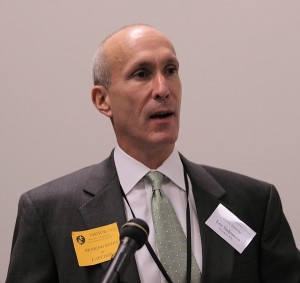Toxic Polluters Writing DEP Cleanup Regulations
Christie DEP Mimics Bush/Cheney Energy Taskforce
We bring in all different organizations so that we’re getting all different points of view before we make decisions. ~~~ DEP Commissioner Bob Martin (watch it)
We can cut through unnecessary red tape and provide real solutions to real-world problems, while maintaining our high protective standards. ~~~ DEP Commissioner Bob Martin said. (read it)
Closely following the testimony I delivered on December 9, 2010 to the Senate Environment Committee (see: DEP Puts Lipstick on Industry Dominated Toxic Site “Reform” Pig, today Jim O’neill of the Bergen Record wrote a killer story: Polluters rewriting rules for site cleanup.
O’Neill’s reporting flat out contradicts DEP Commisisoner Martin’s claims about seeking “different points of view”. The story begins:
Key committees writing rules for New Jersey’s new program to clean up contaminated sites are made up entirely of the polluting companies and their contractors.
The 16 committees, which have been putting together rule and guidance documents, include no one from environmental or resident advocacy groups, no health specialists, and no outside experts who aren’t affiliated with the cleanup industry.
“It’s a who’s who of corporate polluters and their hired consultants”, said the New Jersey Sierra Club’s Jeff Tittel. “These oversight rules will be written so loosely there will be nothing to enforce later.”
Well, so much for Martin’s commitment to obtaining “all different points of view” before making decisions! DEP proposed rules on May 2, 2011.
But that’s not the only DEP lie foisted on the public – the more important lie is about ongoing DEP efforts to weaken public health and environmental standards.
Importantly, O’Neill broke a very important aspect of this rollback effort. For the first time, DEP is on record as saying they plan to revise cleanup standards:
The DEP is also creating a group of committees to revise the actual standards for cleanup the levels of contamination that can remain after cleanup depending on the site’s future use.
This contradicts repeated DEP assurances that current cleanup standards would be retained.
During debates on the controversial privatization of NJ’s toxic site cleanup program, the public was given repeated assurances by legislators and DEP that DEP would retain current stringent health and environmental standards, including current soil, groundwater, surface water, vapor intrusion, and drinking water standards.
But those repeated assurances have been betrayed.
When I warned the Senate Environment Committee on December 9, 2010 that standards would be weakened, Committee Chairman Bob Smith challenged that testimony and repeated DEP’s assurance that cleanup standards would NOT be weakened. I urge anyone with doubts to listen to the testimony, including my exchange with Chairman Smith, which begins at time 1:26:20)
Current DEP Commissioner Martin is violating a commitment of his predessor and thus legislative intent, which was based on those commitments that standards would be retained.
On April 15, 2008,DEP Commissioner Lisa Jackson testified to the Legislature:
Under this plan, [toxic site cleanup] cases will be adddressed rapidly and properties will be developed to desired uses. We will be cleaning up sites and stimulating economic vitality vitality. We will not compromise on our standards or protection of the environment and public health. Nor will we delegate the inherently governmental functions of site remediation to private entities. The Department will maintain the functions associated with the issuance all NFA’s, review all cases with receptor and off-site contaminant migration impacts, audit cases based on potential risks and expand our oversight for the “worst” cases and for those with recalcitrant responsible parties.
But the Christie Administration’s new policy is even worse than that.
Vapor intrusion decisions are inherently governmental functions and essential public health protections.
Vapor intrusion sites are high risk cases that are required to remain under direct DEP oversight.
Delegating decisions on vapor intrusion to private entities and allowing them to exercise judgement in the absence of regulatory standards is absurd – get the whole story on DEP’s May 2, 2011 rule proposal below from our friends at PEER:
[Note 1: DEP summary of the SRRA does not even mention the mandate in Section 39 to adopt a “remedial priority system” (RPS) by May 2010.
The RPS was designed as the mechanism by which DEP would prepare a risk based cleanup priority list and retain direct oversight of high risk cases while the LSP’s were given low risk cases. Obviously direct contact exposure vapor intrusion would be a high risk case that would be under direct DEP regulatory oversight under the standards in the Vapor Intrusion Guidance, not an LSP case allowing discretionary use of “best professional judgement” to determine if vapor investigation is necessary and whether or not to mitigate.]
[Note 2: The Department could have proposed a rule that provided for direct DEP oversight of vapor intrusion cases. They chose not to do that. The Department’s proposal and various facts sheets all fail to address the RPS mandate and risk based criteria for the DEP to retain direct regualtory oversight. Here is the statutory language – look specifically at b. 4 below:
C.58:10C-27 Direct oversight of remediation by department; conditions
b. The department may undertake direct oversight of a remediation of a contaminated site under the following conditions:
(1) the contamination at the site includes chromate chemical production waste;(2) the department determines that more than one environmentally sensitive natural resource has been injured by contamination from the site;
(3) the site has contributed to sediments contaminated by polychlorinated biphenyl, mercury, arsenic, or dioxin in a surface water body; or
(4) the site is ranked by the department in the category requiring the highest priority pursuant to the ranking system developed pursuant to section 2 of P.L.1982, c.202 (C.58:10-23.16).
Management 101 – set priorities.
[Update #1 – even the DEP acknowledges that their job is to retain direct oversight of the highest risk cases. In a recent regulatory adoption, DEP responded (to my comment opposing a “safety cushion”, code for elimination of mandatory timeframes) as follows:
Placing a significant number of cases under direct oversight would defeat the purpose of the LSRP program, which was to relieve the Department from overseeing the remediation of every case in favor of having enough resources for the Department to focus on the cases that pose the greatest risk to public heath and the environment.(@ page 25)
So, exactly what are those cases? What are the sites that pose the greatest risk to public health and the environment?
Shouldn’t we know this before giving ANY site to an LSP?

